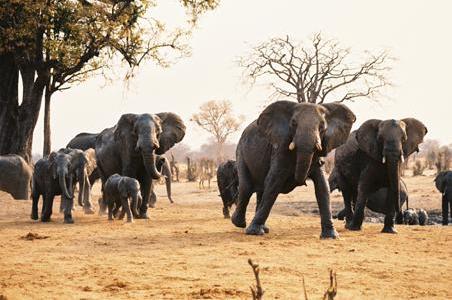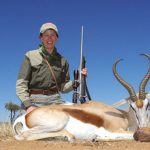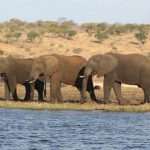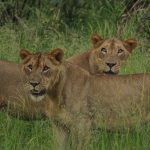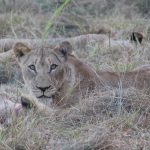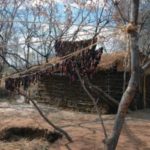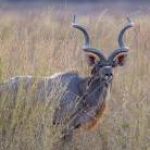Elephant overpopulation has caused an environmental crisis, and safari hunting is taking the blame.
I’m concerned about recent developments here in southern Africa. I write this because the pending closure (at the end of 2013) of all sport hunting on public land and Controlled Hunting Areas in Botswana is seriously bad news. What makes this situation so ridiculous is the reason behind this draconian governmental decision. To quote from a press statement issued by the Botswana Ministry of Environment, Wildlife and Tourism dated November 29, 2012, “The decision to impose this moratorium on hunting was made in the context of a growing concern about a sharp decline in the populations of most of the wildlife species that have been subject to licensed hunting.”
In a nutshell, sport hunting is being blamed as the root cause of the dramatic decline in numbers of both predators and the various and diverse antelope species that occur naturally in northern Botswana and the Okavango Delta. This is ridiculous.
Many theories are being bandied about as to the reason for the alarming decline in Botswana’s antelope numbers (and consequently the predators that prey upon them), with prolonged drought and a reduction in water flow into the swamps being the most prominent. Yet to all of us who love Africa and its wildlife, the real cause is blatantly obvious despite the fact that everyone seems to be pussyfooting around it. Nobody seems to have the intestinal fortitude to stand up and say what really needs to be said —so I will. The truth is simply this: Botswana has too many elephants. Way too many, in fact, and it is their influence on the environment that is impacting all the other species.
Available on the internet is a fascinating article by David Cumming and Brian Jones of the WWF (World Wide Fund For Nature). The article is entitled “Elephants in Southern Africa: management issues and options.” (http://www.fitzpatrick.uct.ac.za/publications/Cumming_Jones_2005.pdf) Published in 2005, it is now somewhat dated; nonetheless, it makes for fascinating reading. The elephant population figures it provides are eye-openers. According to the article, southern Africa’s elephant populations had collapsed by the 1880s, primarily due to overhunting. Thanks to dedicated conservation efforts since that time, begun in the colonial era and then continued in a fashion by the game departments of the various newly independent southern African countries (Zambia, Zimbabwe, Mozambique, Botswana, Namibia, and South Africa), elephant numbers have increased dramatically. From only a few thousand in the late 1800s, southern Africa’s combined elephant population has increased to somewhere in the region of 300,000 today.
Botswana currently has the largest elephant population. In the early 1960s there were less than 10,000 pachyderms in this landlocked and generally dry country. Since that time their numbers have increased steadily by about 5 to 6 percent annually. By 1990 there were 50,000 elephants in the wetter, northern parts of the country and in the following year the Botswana Department of Wildlife Conservation and National Parks drew up a draft elephant management policy. In that year (1991), it was established that the then-current elephant population of 55,000 was the maximum the country could sustain without the eventual loss of habitat so essential for species biodiversity. Unfortunately, the policy was never adopted or implemented even though it made the recommendation that management of elephant numbers was necessary because of their impact on habitat. Instead, Botswana’s elephant numbers continued to increase steadily and exponentially. By 1995 the population had increased to 80,000. By 2002 some estimates said it was 120,000; by 2005, 140,000; and heaven only knows what it is today. There is much speculation.
When one realizes that 55,000 was the maximum figure that would ensure environmental preservation, it should be blatantly obvious where the problem so conveniently blamed on sport hunting actually lies.
I find the “prolonged drought” excuse a poor one. Drought is nonselective. It affects all herbivores, including elephants. During the so-called drought period, (the 1990s and early 2000s) elephant numbers increased steadily by about 6 percent annually while in the Moremi Game Reserve (which borders the Okavango swamps and where no hunting takes place) giraffe numbers over the same period decreased by 8 percent annually. Kudu numbers also decreased by 11 percent annually, as did lechwe by 7 percent, tsessebe by 13 percent and wildebeest by 18 percent! (Source: Elephants Without Borders paper entitled “Dry Season Fixed-Wing Aerial Survey Of Elephants & Wildlife in Northern Botswana, Sept.-Nov. 2010.”)
Zimbabwe, too, has seen a dramatic increase in elephant numbers. From only a couple of thousand in the early 1900s, their numbers have increased to approximately 100,000 today. Until the mid-1980s, Zimbabwe’s elephant population was maintained at 45,000 by well-organized, professionally conducted, government-regulated culling regimes. Even though I was living in the country at the time, I never got to witness an elephant cull, but I became acquainted with three Department of National Parks and Wildlife officers who had each shot more than 6,000 elephants in the course of their duties.
Zimbabwean independence and subsequent changes in the wildlife department eventually resulted in the loss of the experienced culling teams, and by the late 1980s, all elephant culling came to an end in Zimbabwe. Since that time the country’s elephant population has doubled.
Having spent more than two decades in Zimbabwe, much of it in the Zambezi Valley, I’ve witnessed firsthand what an ever-increasing elephant population can do to the environment. My passion was the sporting pursuit of old dagga-boy buffaloes, and my favorite hunting grounds were the Zambezi Valley’s Nyakasanga and Sapi safari areas. I also hunted in the Makuti and Charara as well as the Rifa Safari Areas. During the early 1990s, bushbuck were a popular add-on species on these buffalo hunts, but as elephant numbers increased, many of the Zambezi Valley’s dense riverine vegetation areas started to open up due to increasing elephant feeding pressure. These were the areas favored by these secretive, highly territorial antelope. Eventually the bushbuck lost much of their habitat and when this happened they simply disappeared. By the early 2000s it wasn’t worth purchasing a bushbuck license, so uncommon had they become.
A similar scenario has evolved in South Africa’s well-known Kruger National Park. Up until 1995 the park’s elephant population was kept below 8,000 by a regular, carefully managed, scientifically evaluated culling program. International pressure put an end to the culling, and since that time the park’s elephant population has doubled. The result of this has been an 80 percent reduction in top canopy trees, very evident habitat change, and considerable public alarm and condemnation at the pending loss of the park’s biodiversity. The park’s rarer antelope species like sable, roan, and nyala have just about disappeared, which is most unfortunate.
To me the solution to the Botswana problem is obvious—get the elephant numbers back to where they should be. Unfortunately this is something easier said than done because it is already too late for a massive culling program. Human sentiment, heated emotions, politics, and the greenies have long since entered the picture and the situation has become confusing, illogical, and directionless.
To me it seems that southern Africa’s elephants have attained almost ambassadorial status. Culling to keep their numbers in check and to preserve the environment is now simply taboo, with threats of boycotts and even economic sanctions being leveled at countries when the mere suggestion of any form of a culling program has been raised.
In my opinion, a life is a life. Is the life of an elephant more important or sacred than that of a giraffe, for example, or a kudu, which disappears because it no longer has trees to feed on? Everything in nature needs to be in balance, and when the balance tips too far in favor of the mega-herbivores, everything else falls apart.
The sad situation is that everyone seems so paranoid about the elephants and their preservation at all costs that they appear to have forgotten about the other (and, in my opinion, equally important) African wildlife species. I can’t help but wonder: Where are the greenies championing the cause of the giraffe, kudu, or bushbuck, or that of the many bird species which have lost their nesting sites due to all the trees being destroyed? Sadly, none of these species seem to stir the emotions strongly enough to rake in the gullible public’s donation dollars. This, of course, elephants do very well, and this is the root cause of the problem.
The worrying aspect is finding a logical solution to the problem and then implementing it. Banning sport hunting is not going to make all these problems disappear—that is for sure. You and I both know this. In fact, it is only going to make things worse. Subsistence poaching is going to escalate as rural communities lose the funds sport hunting once generated. When this happens, even more pressure is going to be placed upon the dwindling antelope numbers. When wildlife loses its economic value, it is replaced with something that is valuable. Look at what has happened in Kenya, for example. This once wonderfully rich wildlife country has, since the banning of sport hunting, lost 80 percent of its wildlife. Only time will tell if Botswana walks the same path.
Unfortunately, I have no solution to the elephant problem. At their current rate of population growth it is predicted that there will be in excess of 500,000 of them in southern Africa by 2020. Is this likely to happen? I doubt it. Nature is smarter than all of us. Something is going to crash, and when it does I’m sure it will not be pleasant. Unfortunately it’s going to be the other wildlife species that will be affected most. Massive environmental degradation and the loss of Botswana’s biodiversity is a disaster just waiting to happen. Sport hunting could have been part of the solution. Instead it is being used as an excuse for poor environmental management and now it is about to be banned. Where is the logic in this?–Dr. Kevin Robertson

